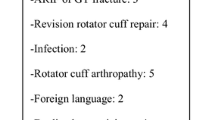Abstract
Background
Despite arthroscopic repair of the rotator cuff is an increasingly popular procedure, the mini-open (MO) repair still remains a viable and appreciated technique. The purpose of the study was to analyze the long-term clinical outcomes of patients with isolated supraspinatus tear undergoing MO or arthroscopic surgery (AS) repair.
Patients and methods
Forty-six patients underwent supraspinatus repair with anchors: 24 with MO technique and 22 with AS procedure. They were evaluated postoperatively at 3, 6, 12 months and 2 years.
Results
The mean surgery time, the mean hospital stay and the average costs were shorter in the MO patients respect to the AS group. Despite an initial better Disabilities of Arm, Shoulder and Hand and Constant Murley Score in the first 6 months of follow-up in the AS group, no differences were detected at 24 months.
Conclusion
This study suggests that isolated supraspinatus tears can be treated with a MO or arthroscopic repair procedure with similar clinical outcome in the long-term postoperative period. The mean surgery time and the average costs are less in the MO group respect to the AS group.





Similar content being viewed by others
References
Liu J, Fan L, Zhu Y et al (2017) Comparison of clinical outcomes in all-arthroscopic versus mini-open repair of rotator cuff tears. Medicine (USA) 96:1–7. https://doi.org/10.1097/MD.0000000000006322
Pearsall AW, Ibrahim KA, Madanagopal SG (2007) The results of arthroscopic versus mini-open repair for rotator cuff tears at mid-term follow-up. J Orthop Surg Res 2:1–8. https://doi.org/10.1186/1749-799X-2-24
Oliva F, Piccirilli E, Bossa M et al (2015) I.S.Mu.L.T—rotator cuff tears guidelines. Muscles Ligaments Tendons J 5:227–263. https://doi.org/10.11138/mltj/2015.5.4.227
Baudi P, Dani ER, Campochiaro G et al (2013) The rotator cuff tear repair with a new arthroscopic transosseous system: the Sharc-FT®. Musculoskelet Surg 97:57–61. https://doi.org/10.1007/s12306-013-0254-3
Merolla G, Chillemi C, Franceschini V et al (2014) Tendon transfer for irreparable rotator cuff tears: indications and surgical rationale. Muscles Ligaments Tendons J 4:425–432. https://doi.org/10.11138/mltj/2014.4.4.425
Patte D (1990) Classification of rotator cuff lesions. Clin Orthop Relat Res 254:81–86
Donohue NK, Prisco ARP, Grindel SI (2017) Pre-operative corticosteroid injections improve functional outcomes in patients undergoing arthroscopic repair of high-grade partial-thickness rotator cuff tears. Muscle Ligaments Tendons J 7:34. https://doi.org/10.11138/mltj/2017.7.1.034
Hudak PL, Amadio PC, Bombardier C et al (1996) Development of an upper extremity outcome measure: the DASH (disabilities of the arm, shoulder, and head). Am J Ind Med 29:602–608. https://doi.org/10.1002/(SICI)1097-0274(199606)29:6<602::AID-AJIM4>3.0.CO;2-L
Constant CR, Murley AH (1987) A clinical method of functional assessment of the shoulder. Clin Orthop Relat Res 214:160–164
Ghodadra NS, Provencher MT, Verma NN et al (2009) Open, mini-open, and all-arthroscopic rotator cuff repair surgery: indications and implications for rehabilitation. J Orthop Sports Phys Ther 39:81-A6. https://doi.org/10.2519/jospt.2009.2918
Cho C-H, Song K-S, Jung G-H et al (2012) Early postoperative outcomes between arthroscopic and mini-open repair for rotator cuff tears. Orthopedics 35:e1347–e1352. https://doi.org/10.3928/01477447-20120822-20
van der Zwaal P, Thomassen BJW, Nieuwenhuijse MJ et al (2013) Clinical outcome in all-arthroscopic versus mini-open rotator cuff repair in small to medium-sized tears: a randomized controlled trial in 100 patients with 1-year follow-up. Arthrosc J Arthrosc Relat Surg 29:266–273. https://doi.org/10.1016/j.arthro.2012.08.022
Verma NN, Dunn W, Adler RS et al (2006) All-arthroscopic versus mini-open rotator cuff repair: a retrospective review with minimum 2-year follow-up. Arthrosc J Arthrosc Relat Surg 22:587–594. https://doi.org/10.1016/j.arthro.2006.01.019
Ji X, Bi C, Wang F, Wang Q (2015) Arthroscopic versus mini-open rotator cuff repair: an up-to-date meta-analysis of randomized controlled trials. Arthrosc J Arthrosc Relat Surg 31:118–124. https://doi.org/10.1016/j.arthro.2014.08.017
Hui YJ, Teo AQA, Sharma S et al (2017) Immediate costs of mini-open versus arthroscopic rotator cuff repair in an Asian population. J Orthop Surg 25:1–6. https://doi.org/10.1177/2309499016684496
Kasten P, Keil C, Grieser T et al (2011) Prospective randomised comparison of arthroscopic versus mini-open rotator cuff repair of the supraspinatus tendon. Int Orthop 35:1663–1670. https://doi.org/10.1007/s00264-011-1262-2
Churchill RS, Ghorai JK (2010) Total cost and operating room time comparison of rotator cuff repair techniques at low, intermediate, and high volume centers: mini-open versus all-arthroscopic. J Shoulder Elb Surg 19:716–721. https://doi.org/10.1016/j.jse.2009.10.011
Huang R, Wang S, Wang Y et al (2016) Systematic review of all-arthroscopic versus mini-open repair of rotator cuff tears: a meta-analysis. Sci Rep 6:22857. https://doi.org/10.1038/srep22857
Morse K, Davis AD, Afra R et al (2008) Arthroscopic versus mini-open rotator cuff repair. Am J Sports Med 36:1824–1828. https://doi.org/10.1177/0363546508322903
Verdano MA, Pellegrini A, Scita G et al (2013) Arthroscopic treatment for cuff tear: strength recovery at 12 months of follow-up. Musculoskelet Surg 97:51–56. https://doi.org/10.1007/s12306-013-0241-8
Arrigoni P, Fossati C, Zottarelli L et al (2013) Functional repair in massive immobile rotator cuff tears leads to satisfactory quality of living: results at 3-year follow-up. Musculoskelet Surg 97:73–77. https://doi.org/10.1007/s12306-013-0252-5
Author information
Authors and Affiliations
Corresponding author
Ethics declarations
Conflict of interest
The authors declare that they have no conflict of interest.
Ethical standard
All procedures performed in the study involving human participants were in accordance with the ethical standards of the institutional and/or national research committee and with the 1964 Helsinki declaration and its later amendments or comparable ethical standards.
Informed consent
Informed consent was obtained from all individual participants included in the study.
Rights and permissions
About this article
Cite this article
Vicenti, G., Moretti, L., Carrozzo, M. et al. Evaluation of long-term postoperative outcomes between mini-open and arthroscopic repair for isolated supraspinatus tears: a retrospective analysis. Musculoskelet Surg 102 (Suppl 1), 21–27 (2018). https://doi.org/10.1007/s12306-018-0549-5
Received:
Accepted:
Published:
Issue Date:
DOI: https://doi.org/10.1007/s12306-018-0549-5




